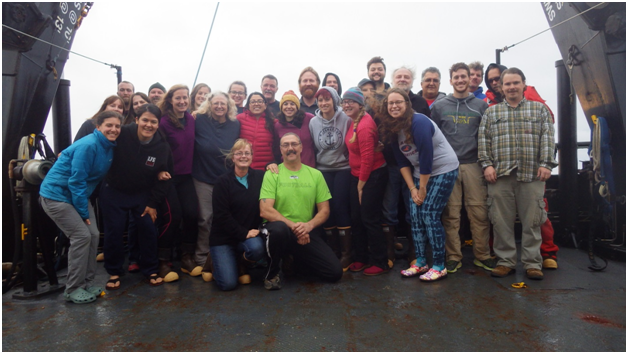
The AMBON team on board the R/V Norseman II in 2017
2017 Research Cruise
This was the daily update for the Arctic Marine Biodiversity Observing Network (AMBON) in the Chukchi Sea in August 2017. The survey occurred on the R/V Norseman II and included the study the plankton, seafloor organisms, fish, birds and marine mammals as well the physical-chemical oceanographic environment. The AMBON team was comprised of scientist from the University of Alaska Fairbanks, the University of Maryland Center for Environmental Science, the University of Washington Applied Physics Lab, the U.S. Fish and Wildlife Service, the National Oceanographic and Atmospheric Administration, and the Alaska Ocean Observing System. The research cruise was supported by the Bureau of Ocean Energy Management, NOAA, and the NSF.
4 August 2017
We experienced some delay on cargo coming in with Alaska Air Cargo and we are hence still in Nome. We anticipate the last of our cargo to arrive in Nome tomorrow, 8/5 and be able to leave for our research cruise around noon or early afternoon.
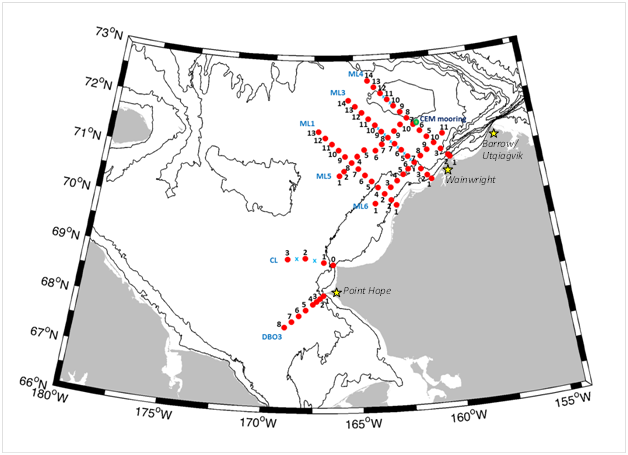
Planned station grid
5 August 2017
After the delay in getting our cargo into Nome, we finally received and loaded everything on board today. Our thanks go to Gay Sheffield, Nome-based agent of the Marine Advisory Program at the College of Fisheries and Ocean Sciences at UAF for all the ground support in Nome. We are also extremely grateful to the R/V Sikuliaq for the valuable help we received in solving a problem with our CTD and we are very grateful for their assistance. At 2:30 pm today, we were able to pull out of Nome harbor and are finally on our way in beautiful sunshine, warm weather and calm seas. Everybody on board is very excited to finally start our mission. On our transit north we have so far seen harbor porpoises, black-legged kittiwakes, gulls, cormorants, and one Pacific loon.
6 August 2017
The night and most of the day was spent steaming towards our first sampling station in the south-central Chukchi Sea. We arrived on our first station, DBO3-8, around 4pm. We kept operations on this first station slow so that all the experienced and new scientists and crew members could all be on the same page, making sure to understand the routines and work together for the best sampling results. We deployed every gear at this station, including a CTD (Conductivity, Temperature, Depth), which gives us profiles of temperature, salinity, oxygen and fluorescence throughout the water column. We then deployed two different zooplankton nets, two different bottom sediment samplers, a midwater fish trawl, and a bottom trawl for bottom fish and bottom invertebrates. We will report on some of these specific gears in the next few daily updates. Sampling went off without a hitch and we have the first full station under our belt.
8 August 2017
Today we worked all the stations along the CL line. The weather started to pick up a little but did not prevent us from working all the gear. One of the highlights of the last two days was the large amount of fish we caught. As typical for the Chukchi Sea, most fish are quite small, but we did catch several larger (and some unusual) sculpins and eelpouts, too. One especially interesting catch was a large Walleye Pollock. The invertebrates in the trawls were mostly large amounts of various shrimp, which also is unusual compared to our findings in 2015.
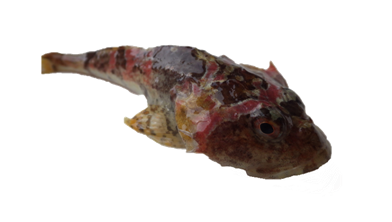
Myoxocephalus, a common nearshore sculpin
9 August 2017
Last night we slowly traveled north, just outside the Critical Eider Habitat Region in Ledyard Bay, as the weather had picked up, making deck work impossible. By his morning, we faced a window of good-enough weather to continue working. The sea swell was still strong, slowing down our progress and necessitating extra care when deploying or recovering gear as well as making sure people were safe. The occasional wave hitting the boat from a bad angle still had us scrambling to hold on to anything solid while making sure the samples didn’t go flying. We still managed to complete 3 stations during the day for most of the gear and hope that the weather will hold long enough for the night shift crew work a few more stations.
10 August 2017
We continued working the ML6 line northward, despite marginal weather at times. Kudos to the crew and scientists for working through the challenging conditions safely and enthusiastically. Late this afternoon, we had to call operations to a halt though because of weather. We will hide out closer to shore for the night and hope to get back into sampling mode soon. Today’s highlight was five gray whale sightings after the marine mammal observations have been very slow ad sparse so far.

Short-tailed shearwater
11 August 2017
We spent the night hiding from the strong south-western winds and then tried sampling station ML4-1 this morning. However, up to 10 ft swells prevented us from deploying some of our scientific gear and we spent the day transiting into deeper waters. We are now at ML6-10 and aim t complete the ML6 line this night. The hours spent transiting today made for exciting seabird observations and we saw four Kittlitz’s murrelets, at least three Pacific loons, several groups of shearwaters, and probably over 200 King eiders close to Peard Bay.
12 August 2017
After our weather hiatus yesterday, we had a very productive night and day today. Stations today were mostly around the head of Barrow Canyon, a hydrographically and topographically complex region. This was shown by a very high diversity and number of individuals of seafloor organisms as well as fishes. At one of our more nearshore stations, we caught more than 600 fish (mostly sculpins) in a single trawl, while more typical numbers are less than 100 fish!

Fish mix!
13 August 2017
Work today progressed extremely well today in stable weather conditions. We sampled over the Hanna Shoal region, known as a prolific walrus feeding ground. And indeed, we did see walrus and we found a lot of clams in our bottom grabs, which are one of the walrus’ favorite food.

The clam Serripes, one of walrus’ favorite food.
14 August 2017
After completing the ML4 line during the night, we then transited to the Chukchi Ecosystem Observatory mooring array, which is located close to ML4-7. There are two moorings in this array with continuous measurements being made over the course of the year of water parameters such as temperature, salinity and acidity, measurements of microalgal particles in the water column, as well as measurements of zooplankton and small fishes. A hydrophone records marine mammal sounds in the vicinity of the mooring. The benefit of such a mooring is that provides context over the entire year for the short-term measurements that we are able to make during our cruise. Mooring recoveries and deployments went without problems. Despite a problem we encountered with one of the instruments, we are very happy with the smooth operations and excited about the wealth of data recovered that will keep us busy for months to come.
15 August 2017
Aside from station work, we again had a pretty long transit, which always is an exciting time for our seabird and marine mammal observers. Today, we saw another Kittletz’s murrelt, which was the 6th of our trip, and it occurred quite far offshore for a typically more coastal species. We also observed many crested auklets feeding on the zooplankton on and just below the water surface. Station work was challenging because of large rolling swells but we still managed a productive day.
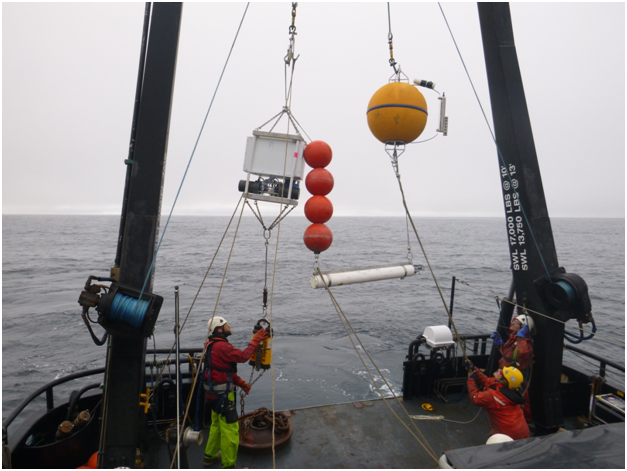
One part of the mooring being deployed, including float (yellow ball), hydrophone (white bar), and water sampler (white box)
16 August 2017
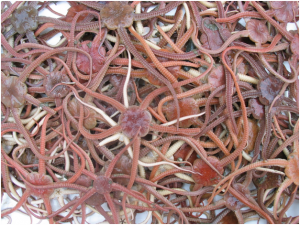
The brittle star Ophiura sarsii en masse….
We worked stations today that run along one of the sampling station lines of the Distributed Biological Observatory (DBO) program (https://www.pmel.noaa.gov/dbo/). The DBO program is arranged around “hotspot” areas of high seafloor biomass and biological activity. These lines are sampled one or several times per year to create understanding of the variation occurring under different seasonal conditions. The sampling went very well, and the seafloor richness was impressively demonstrated by the buckets full of brittle stars that came up with the trawls!
17 August 2017
It was an exciting day for our fish study. The stations relatively close to shore contained very high diversity of fish, some species we had not yet seen during this cruise, as well as some of the largest-sized fish (this is relative to the very small size of most arctic fishes) we have seen so far. In part this has probably to do with the diverse habitat for these fishes as there are many rocks and gravel instead of the more uniform muddy seafloor we find farther offshore. These fish and also some of the invertebrates also may be good food for several of the birds we observed during our transit to the beginning of the ML1 line.
18 August 2017
Work progressed well today with continuing good weather. We continue to observe lower than expected numbers of copepods, the small crustaceans that make much of the base of the marine food web. We reported on this earlier and the trend continues. Simultaneously, we keep seeing large jellies, which probably exert strong predation pressure on these copepods. The good news is though that we see feeding seabirds, whose prey are mostly copepods, meaning the birds still seem to be finding food.
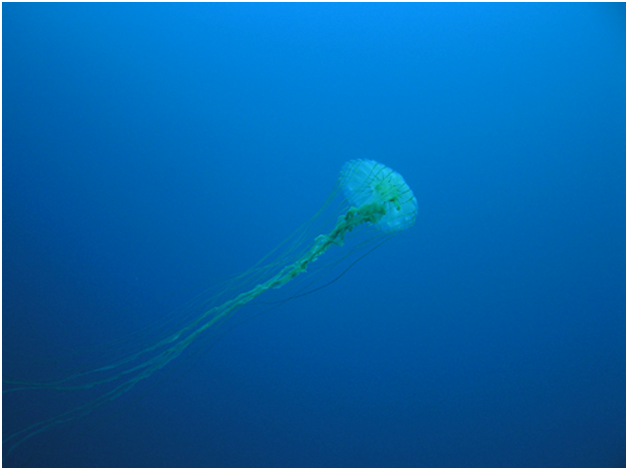
The large jelly, Chrysaora, which competes for zooplankton food with many of the seabirds.
19 August 2017
Our night shift team finished up the ML1 line so that we could start our transit to the remaining stations on ML5 in the morning. Calm weather ad very good visibility made for excellent observing conditions of marine mammals and seabirds. We observed a good number of large flocks of crested auklets during this transit. Station work commenced in the late afternoon at station ML5-7.
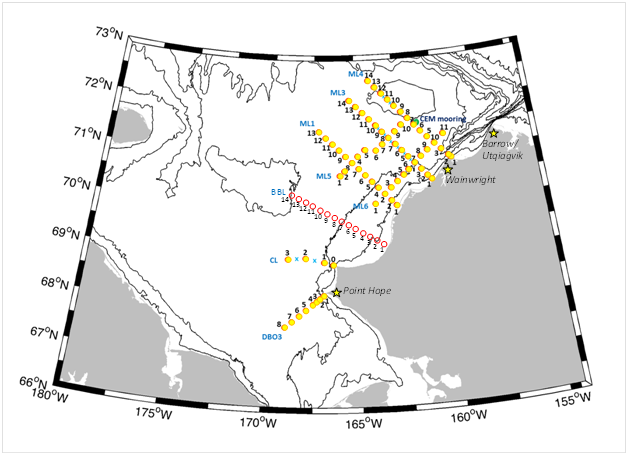
Location of the new BBL line (yellow indicates completed stations).
20 August 2017
We completed the ML5 line and with that, our regular sampling program. Because we had fewer weather days than anticipated, we will be able to sample some more stations along the new BBL line. We are very excited to fill a “gap” in our coverage and with that, in our understanding of the system between the southern and the northern Chukchi Sea. Now we hope that the weather will hold a few more days so we can complete this last line.
21 August 2017
We started the BBL line during the night with very calm seas. Yet, during the early morning hours, the inds started to pick up, just as the forecast had predicted. We kept working during the day until we had to call operations because waves kept crashing over the back deck, hoping for a window of clam soon so we can continue with this line. During our bottom sampling, we found a lot of sand dollars today – those are very flat sea urchins that live in muddy substrates. However, our sand dollars were all extremely small in size, so we really only found “sand pennies….”!
22 August 2017
Luckily, we were able to make good use of a good weather window and we are nearly done with our planned stations. We are now holding out for a few more hours to see if we can get the last 2 stations in before heading back towards Nome. No matter what we will still be able to do over the next 12 hours, this cruise has been hugely successful and we have collected a lot of valuable samples and information.
23 August 2017
The weather did not improve at our stations, so we finally left our study area around midnight and started our return south towards Nome. In the early afternoon we crossed the location where a NOAA mooring had failed to release from its bottom anchor just the week before. We dragged for the mooring and were able to recover it. Excellent job, Norseman II crew!! On this happy note, we have completed our science mission, except for the bird and mammal observations, which will continue until we reach Nome. The rest of us will spend the remainder of our transit time cleaning and packing our gear.
24 August 2017
The day was spent transiting towards Nome while the science team was mostly busy with cleaning and packing gear. A highlight was the observation of several gray and fin whales, especially we have not seen many whales during this trip.
Since we do not plan on any more science until the arrival in Nome, this will be the last daily update from the AMBON cruise. Thank you for the opportunity to share our work and observations.

The completed station grid.
